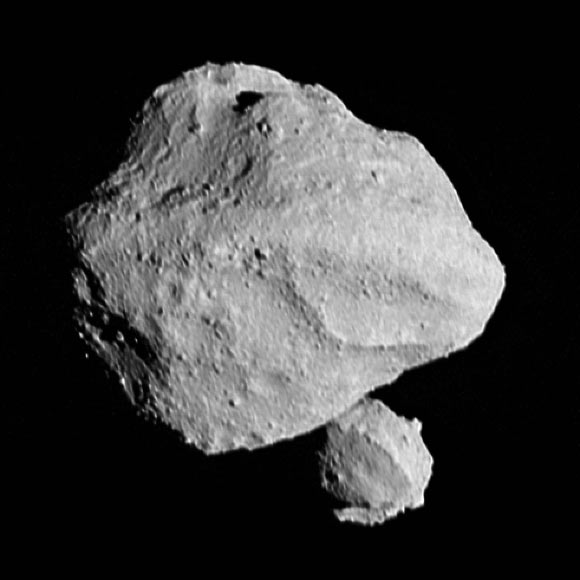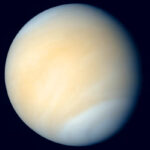On November 1, NASA’s Lucy spacecraft flew by not just its first asteroid — the small main-belt asteroid (152830) Dinkinesh — but its first two. The first images returned by Lucy reveal that Dinkinesh is actually a binary asteroid.
This image, captured by the Lucy Long-Range Reconnaissance Imager (L’LORRI) onboard NASA’s Lucy spacecraft, shows the main-belt asteroid Dinkinesh and its moonlet. This image was taken at 12:55 p.m. EDT (16:55 UTC) on November 1, 2023, within a minute of closest approach, from a range of approximately 430 km (270 miles). Image credit: NASA’s Goddard Space Flight Center / SwRI / Johns Hopkins APL / NOIRLab.
Dinkinesh, also known as 1999 VD57, is a stony asteroid located in the main asteroid belt situated between Mars and Jupiter.
It was discovered by the Lincoln Near-Earth Asteroid Research (LINEAR) survey on November 4, 1999.
It rotates with a period of 52.67 hours and varies in brightness with a light curve amplitude of 0.39 magnitudes.
“Dinkinesh really did live up to its name; this is marvelous,” said Lucy principal investigator Dr. Hal Levison, a researcher at the Southwest Research Institute, referring to the meaning of Dinkinesh (‘you are marvelous’) in Amharic.
“When Lucy was originally selected for flight, we planned to flyby seven asteroids. With the addition of Dinkinesh, two Trojan moons, and now this satellite, we’ve turned it up to 11.”
From a preliminary analysis of the first available images, Dr. Levison and colleagues estimate that the larger body is approximately 790 m (0.5 miles) at its widest, while the smaller is about 220 m (0.15 miles) in size.
This flyby of Dinkinesh primarily served as an in-flight test of the spacecraft, specifically focusing on testing the systems that allow Lucy to autonomously track an asteroid as it flies past at 16,000 km per hour (10,000 mph), referred to as the terminal tracking system.
“We have seen many asteroids up close, and one may think little is left to discover and surprise us. Well, that is clearly wrong,” said Lucy deputy principal investigator Dr. Simone Marchi, also from the Southwest Research Institute.
“Dinkinesh, and its enigmatic moonlet, differ in some interesting ways from the similarly sized near-Earth asteroids that have been seen by spacecraft like OSIRIS-REx and DART.”
“This is an awesome series of images,” said Tom Kennedy, Lucy’s guidance and navigation engineer at Lockheed Martin.
“They indicate that the terminal tracking system worked as intended, even when the universe presented us with a more difficult target than we expected.”
“It’s one thing to simulate, test, and practice. It’s another thing entirely to see it actually happen.”
While this encounter was carried out as an engineering test, the Lucy scientists are excitedly poring over the data to glean insights into the nature of small asteroids.
“Sharing the anticipation of viewing the first images with the team has been incredibly thrilling, as has been the lively discussion regarding the geology of these two remarkably small yet fascinatingly intriguing targets,” said Dr. Silvia Protopa, a researcher at the Southwest Research Institute.
“I am eagerly looking forward to unraveling the color variations across this binary system.”
“We knew this was going to be the smallest main belt asteroid ever seen up close,” said Lucy project scientist Dr. Keith Noll, a researcher at NASA’s Goddard Space Flight Center.
“The fact that it is two makes it even more exciting. In some ways these asteroids look similar to the near-Earth asteroid binary Didymos and Dimorphos that DART saw, but there are some really interesting differences that we will be investigating.”
The Lucy researchers will continue to downlink the remainder of the encounter data from the spacecraft over the next week.
They will use the data to evaluate Lucy’s behavior during the encounter and prepare for the next close-up look at an asteroid, the main-belt asteroid Donaldjohanson, in 2025.
Lucy will then be well prepared to observe the mission’s main targets, the Jupiter Trojan asteroids, starting in 2027.




